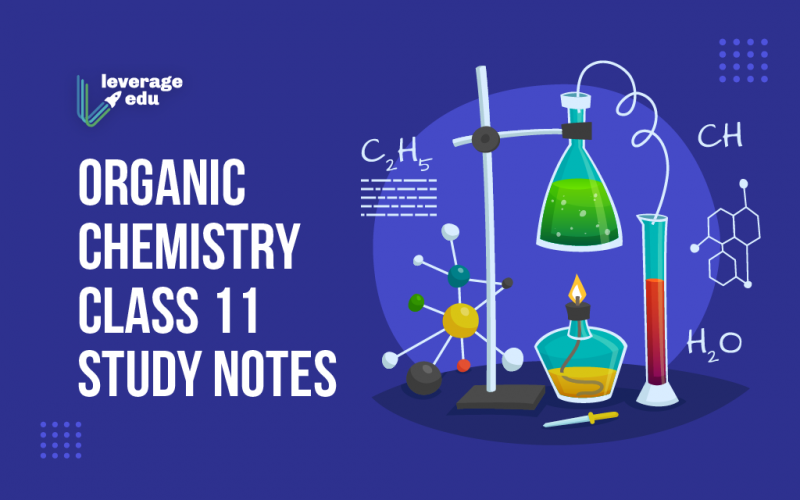Almost all life on earth is of carbon compounds. Organic chemistry is an essential branch of basic chemistry that includes carbon compounds and chains of hydrocarbons. A few of the applications of organic compounds are medicines, clothes, food, fuels, etc. These are examples of chemistry in everyday life. In this blog, let’s study the various classifications and types in organic chemistry class 11.
This Blog Includes:
Must Read: Class 11 Chemistry Syllabus
Overview
What began as a ‘Vital Force’ when chemists began segregating organic and inorganic compounds, has now taken various bonds. The first organic compound synthesis led to the rejection of the vital force theory in 1828 when F. Wohler synthesized urea from ammonium cyanate.
NH4 CNO (Ammonium cyanate) ——-> NH2 CONH2 (Urea)
This breakthrough gave rise to the synthesis of acetic acid by Hermann Kolbe (1945) and methane which led to the notion that organic compounds can be synthesized.
Classification of Organic Compounds
Since carbon compounds have a huge structure and are expanding in numbers there is a need to classify them based on their structures. Here are the classifications of organic compounds in organic chemistry class 11.
Acyclic or Open-Chain Compounds
We now move on to Acyclic or Open-Chain Compounds in organic chemistry class 11. Also known as aliphatic compounds, these compounds form straight chains or branched chains.
For example:
Cyclic or Closed-chain Compounds
Also called Alicyclic or closed-chain compounds, these compounds are joined together in the form of ring-like structures. When the chain has carbon atoms linked together, they are known as Homocyclic compounds. The structures that have some other atoms present in the chain are called Heterocyclic compounds.
Functional Groups
Functional groups are groups of atoms with molecules that have their own functional properties. They form a homologous series or ‘homologues’. Carbon atoms form different chains and often have the same general formula. Among the many homologous series in organic compounds, some commonly used functional groups are amines, ketones, carboxylic acids, alcohols, and ethers.
IUPAC Nomenclature Of Organic Compounds
For many years organic compounds were named after their origination or properties. These were called trivial/traditional names, and a few of them are even used today—for example, citric acid, Buckminsterfullerene (C60). However, with millions of compounds, it is necessary to have a specified naming and identification method. The IUPAC (International Union of Pure and Applied Chemistry) nomenclature is an important part of organic chemistry class 11. According to the IUPAC system, the organic compound is named after identifying the parent hydrocarbons and the functional group.
Nomenclature of Straight Chain Hydrocarbons
The nomenclature of straight-chain hydrocarbons is decided according to their structure. The suffix -ane is common along with a prefix depending on the number of carbons present in the chain. (exceptions are: CH4, C2H6, C3H8, C4H10,)
Nomenclature of Branched Chain Hydrocarbons
Branched chain hydrocarbons are more complex than straight chains. The chains are formed when smaller chains of carbon atoms are attached to a ‘parent’ chain. The smaller chains are called ‘Alkyl’ groups. The names of these alkyl groups are prefixed to their parent alkane. They are then given the names of their saturated hydrocarbon by removing one hydrogen atom from the compound. For example, CH4 becomes -CH3 which is then called ‘Methyl Group’ instead of ‘Methane’.
Also Read: NCERT Chemistry Class 11
Rules of branched-chain alkanes
The most number of branched chains come under Alkanes. Hence, there are some designated rules for naming branched-chain alkanes.
- The molecule’s longest chain is identified, which is known as the parent chain/root chain.
- The numbering of carbon atoms is based on the substituent alkyl group. Numbering must begin from the carbon atom that is nearest to the branched-chain so that they get the lowest number.
- The names of the branched alkyl group are further prefixed to the parent alkane. The numbers are given according to their position and the different alkyl groups are named alphabetically.
- If there are more than two similar groups, then they are separated using commas. Instead of alphabetical order, the prefixes are given as di (2), tri (3), tetra (4), Penta (5), Hexa (6), etc.
- If there are two branches in equal positions, the lower number should be given to the one coming first in the alphabetical order.
- If the alkyl group attached to the parent chain is branched, then they are also further numbered. The group directly attached to the chain is given number 1 and are named in parentheses.
Nomenclature of Organic Compounds Having Functional Groups
Here is a table showing the nomenclature of Organic Compounds having functional groups. Have a look here:
Explore: Chemistry Projects for Class 11
This was all about the organic chemistry class 11 notes. We hope our notes help you ace your exam. For more study notes, stay tuned to Leverage Edu!

 One app for all your study abroad needs
One app for all your study abroad needs






















 45,000+ students trusted us with their dreams. Take the first step today!
45,000+ students trusted us with their dreams. Take the first step today!


